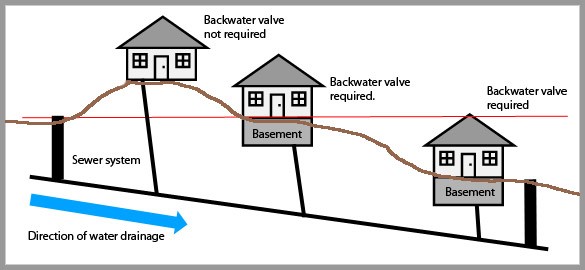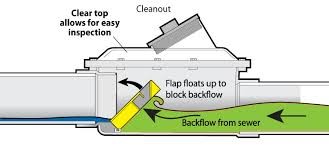
Backwater Valves – Do You Need One?
There is nothing worse than losing personal belongings due to the sewer backing up into your home, not to mention the smell, mess and expense. Sadly, many homeowners have experienced this firsthand. During spring runoff and/or rainstorms, an excessive amount of water can enter the sewer system and cause flooding in homes. Can this be prevented? Yes. If you live in an area that is prone to flooding or are in a low-lying area, a backwater valve would be a good idea so you won’t have to worry about sewer back-ups. Some cities even offer subsidies or rebates to have them installed so check with your local area.
A backwater valve, also called a backflow preventer, is a device installed on the sewer line or drainage line in the basement of a house to prevent the sewer from backing up into your home. Whenever there are heavy rains, the sewers can’t handle the extra water so the excess water backs up into the surrounding homes. A backwater valve is basically a flap that closes to prevent that sewer water from coming into the home.
The valve is usually installed in the same area as the clean-out used for the sewer or drain line. That means the pipe in the basement will have to be dug up to install this valve. An access cover will be needed so the valve can be maintained and tested regularly.
A backwater valve is a mechanical device in a dirty environment that requires regular maintenance and cleaning. Manufacturer’s recommendations for the type and frequency of maintenance should be carefully followed. Generally it needs to be tested and cleaned once annually to ensure it will work when you need it the most. You can either do this yourself or call a professional.
The backwater valve also will need some parts changed every few years but overall it is a very good investment to protect your home and belongings. The cost of a professional clean-up and loss of personal items for just one flooding is generally much higher than having a backwater valve installed.
Should you decide to have one installed, make sure the company is qualified to do so. Installation of a backwater valve is not simple or easy and needs to be performed by a licensed and qualified plumber. Because there are a number of code requirements pertaining to backwater valves, a plumbing permit is required for installation. A plumbing inspection following installation will confirm that the contractor has installed it correctly.
Does a backwater valve guarantee there won’t be any more backups? No. The valve needs to be installed correctly, including the location, orientation and position. If the plumber is not diligent in ensuring that the manufacturer’s specifications are followed, the backwater valve may not operate correctly when you need it to. Also, if the valve has not been correctly maintained at least annually since installation as per manufacturer’s specifications, it may not function as expected. Take the time to understand how it is to be installed, how it works and how to maintain it. Ask for proof of the plumber’s licence and insurance and verify the plumber’s experience in this area.
Many communities offer a rebate for having a backwater valve installed. Check with your local community to see if a rebate is available first. Typically, you would get a form to complete which frequently includes getting prices from two to three companies. Then after confirming it’s okay to go ahead, choose one of the companies and after completion, submit the paperwork. It’s best to ask how long the rebate program will last, if there is any closing date the work has to be done by, and the best time to submit. There may be a limited monthly or program quota so if you’re approved, it’s best to move quickly.
PLEASE NOTE: Don’t forget that if your backwater valve closes during a time of heavy rain or rapid snow melting, that means your drainage line is sealed off from the sewer line. Don’t use a lot of water such as when doing laundry, using the dishwasher, showering or flushing all the toilets. With your home’s plumbing having limited storage capacity, it means that it will quickly fill up and the sewage will start backing up into your home due to the valve being closed. A rainstorm is not the time to catch up on laundry! Some who had backwater valves installed still had their homes flooded. Needless to say they were quite surprised to hear that they did it to themselves.
